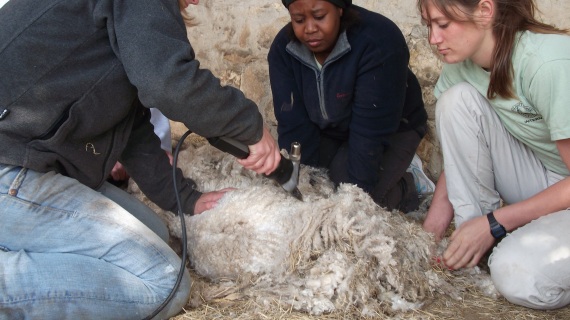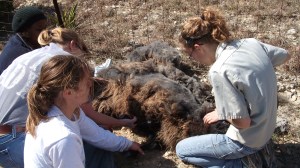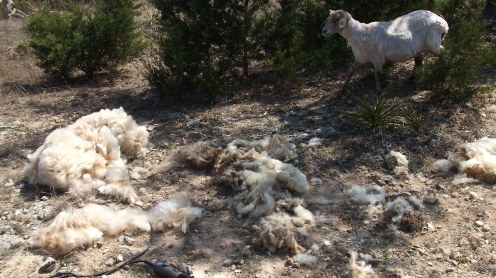
What I most loved about WRR was the variety of animals. I don’t mean the diversity found in a zoo setting–African savannah or Arctic exhibits, for example–but rather the categories of animals. I grouped the critters under one of four labels: companion animals, native wildlife, exotics or livestock. Each type requires specific protocol for handling, rearing and maintenance. Livestock upkeep involves annual sheep shearing, and equine hoof trimming is being introduced at WRR as well. During the course of an internship, it is important to be assertive, especially in the zoological world. I’ve been performing manual labor for free (zero, zip, nada), so to make sure I learned the absolute most from my time at WRR, I weaseled my way into helping with the livestock.
Sheep shearing is as hard core as it gets. The process takes a great amount of focus, commitment, teamwork, communication and muscle. You might be thinking, Baaaah, they’re just grass-eating fluff balls on peg legs. How hard can it be to shear one? Allow me to paint the picture in more detail.
First, all the sheep must be corralled from one pasture into a smaller penned-in area called a lock out. That’s actually the easy part because the sheep tend to follow the food. If you shake a bucket of feed, they’ll more than likely go right where you want them. The hard part is the one-on-one. Minimally–excluding sheep shearing experts–the sheep wrangling takes two people. Sheep must never be looked at straight on because they view this as a challenge associated with predators. As animals of prey, they flee. Honing in on one sheep agreed on by the wranglers, no individual in particular, both people side waddle toward the animal, arms stretched wide. Essentially, this creates a wrestling arena that gets increasingly smaller in size.

When one of the wranglers senses good timing, he or she initiates the contact. Basically, the wrangler dives right in and either grabs the horns or clenches a tuft of fleece. The sheep will buck and jump and thrash and kick, so it is important to be aligned out of harm’s way. Once the sheep has been grasped, he is pulled toward the shearing station. A strong grip must be maintained because the sheep will fight the entire time. If the wrangler loses hold, the sheep becomes so skittish that catching him again in the same day is unlikely.
At the shearing station, the wranglers flip the sheep onto his back by squeezing the legs together and turning him over. Someone comes in with the shears while the sheep is pinned to the ground. Getting the job done as fast as possible minimizes stress on the animal. However, sheep skin is thin and can be sliced almost effortlessly with the blade. While the shearer wants to move quickly, he or she has to keep in mind how much pressure is being put on the blade. If a sheep does get cut, spraying a liquid wound sealer helps minimize blood loss. The metallic silver shine of the spray gives the sheep a hip look, too.
Just like shaving a beard, the blade is a particular width relative to the thickness of the sheep’s coat. The amount of wool that falls off of one sheep would make enough toupees for ten bald men. At WRR, we used the wool as enrichment and bedding. Non-profits make a rule out of the triumvirate idiom “reduce, reuse, recycle.” (Innovation cuts down on finances.)
We discovered a colony of maggots inside the necrotic horn of a male sheep during his shearing. No matter how much we flushed out the area, the wrigglers continued to appear. The odor given off by this dying, infested tissue was even more unbearable than the trailer skunk smell. I think I reached a personal record for time to hold my breath. I didn’t think my job could get more intense than being dragged around on the dirt by an angry sheep, but when you add in the maggots, I think it does.

Hoof trimming on horses, mules and donkeys can be particularly challenging the first time around. Equine hooves are really just giant toe nails. Eating a diet too rich in protein can cause the nails to grow exponentially fast. Hooves can also grow too fast if a horse is given too much water after overheating. Without a rough surface to naturally file the hooves down, caretakers have to manually trim them. All of our equines were rescued from neglectful circumstances in which their hooves foundered. This means they were overgrown to the point that they curled at the tips. The quick in a hoof, or the supply of blood vessels, lengthens during foundering thereby increasing blood flow. Consequently, the hoof becomes hot to the touch. Foundering, also called laminitis, is incredibly painful and, unfortunately, irreversible. But the damage can be lessened if caught in the beginning phases and by continued treatment. Otherwise, the hoof bone can rotate and puncture through the hoof, in which case, due to intense suffering, the animal is humanely euthanized.
In order to make the hoof trimming process run more smoothly, and in the interest of both the animals and caretakers, we implemented tactile training sessions to get the animals accustomed to our touch. Half of our equines feared humans, a result of their abusive past. We needed to earn their trust and gain their comfort in this medical situation. Some days, walking into the pasture with a bowl of carrots and apples, the equines still were not interested in me. To prevent them from regressing, back-pedaling from the progress we’d made up to that point, I would have to postpone the session to another day. Training takes a great deal of patience, which I sometimes don’t have but thankfully am learning to build.
